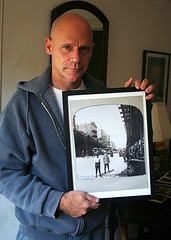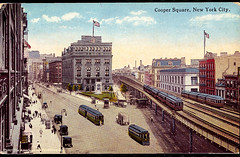 Samantha Ku David Mulkins, chair of the Bowery Alliance of Neighbors, with a 1901 stereoview of the lower Bowery by H.C. White Co. (enlarged below).
Samantha Ku David Mulkins, chair of the Bowery Alliance of Neighbors, with a 1901 stereoview of the lower Bowery by H.C. White Co. (enlarged below).In a closet off the bedroom of his East Fifth Street apartment, David Mulkins stores a treasure trove of old New York artifacts. Stacks of round film reels, piles of papers, photographs and old entertainment posters compose a shrine to the Bowery from the 1800s to the present.
“A lot of people, especially younger people, if they know the Bowery at all, they only know the period when it was known for bars and flophouses,” said Mr. Mulkins. “In the second half of the 20th century, the Bowery was home to some of the most important cutting-edge art that has come out of this country.”
Mr. Mulkins, a high school teacher and 25-year East Village resident, is the chair of the Bowery Alliance of Neighbors, which works to preserve the historic character of the Bowery.
The organization started three years ago to protest the construction of the 21-story Cooper Square Hotel, completed in 2009. “It’s completely out of scale, out of context,” said Mr. Mulkins. “It’s probably the most hated building in this area.”
Currently, the Alliance has a two-pronged approach to the Bowery’s preservation. First, it has submitted an application to have the Bowery included on the National Register of Historic Places. Owners of specific historical buildings would be eligible for tax credits and grants from the state and the city. However, it is not seeking landmark designation from the New York City Landmarks Preservation Commission, which comes with a variety of restrictions, said Mr. Mulkins.
The Bowery Alliance of Neighbors is also working to have the east side of the Bowery rezoned as a low-rise district to match the west side of the street. Though the recent 120-foot height cap on Third and Fourth Avenues gives Mr. Mulkins hope, the Bowery Alliance of Neighbors is seeking even more stringent restrictions on the East Bowery.
“A 120-foot height cap gives tremendous incentive to tear down old buildings to put up high rises,” said Mr. Mulkins. “Whereas 85-foot height caps give somewhat less incentive.”
Like many longtime East Village residents, Mr. Mulkins sees gentrification as the biggest threat to the small business and low-rise tradition of the Bowery. However, the Bowery Alliance of Neighbors has partnered with several new businesses that are causing the recent influx of traffic into the neighborhood — Whole Foods, chef Daniel Boulud’s DBGB, restaurateur Keith McNally’s Pulino’s and John Varvatos, the high-end designer who opened a boutique in the space that housed CBGB.
“Many of the new businesses are sensitive to the history and cultural heritage of where they’re located,” said Mr. Mulkins. He points to the Bowery Wine Company on East First Street, which displays large blowups of old photos of the Bowery, as an example. “They’re in a new building, yet their interior celebrates the history of where they’re located.”
“I love and have always been inspired by this neighborhood,” said Mr. Mulkins. “It’s only recently that I began to wake up to how vulnerable the architectural, cultural and historical heritage is in this area.”
Mr. Mulkins is presenting an illustrated talk called “Bowery: Past, Present and Future” at the Tenement Museum on Nov. 16.





